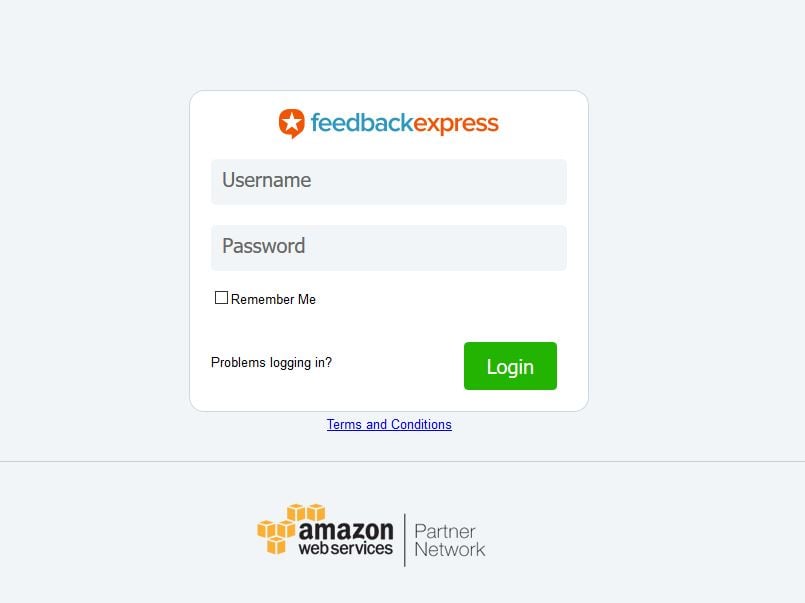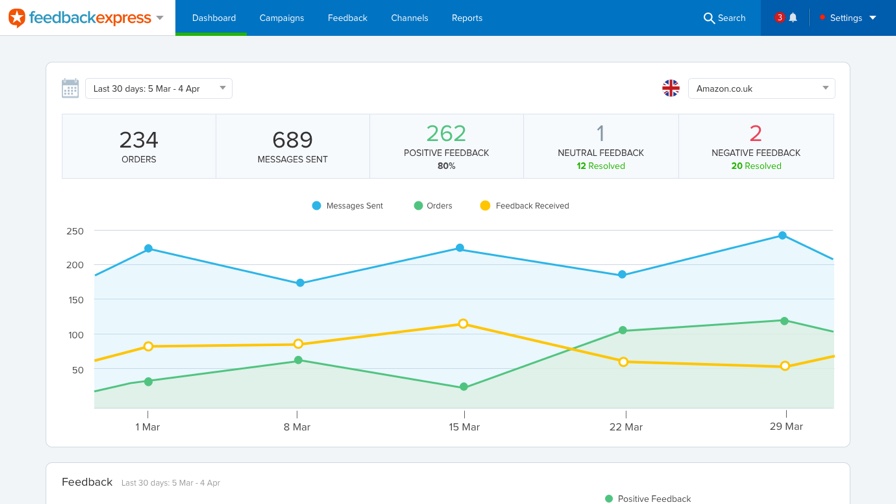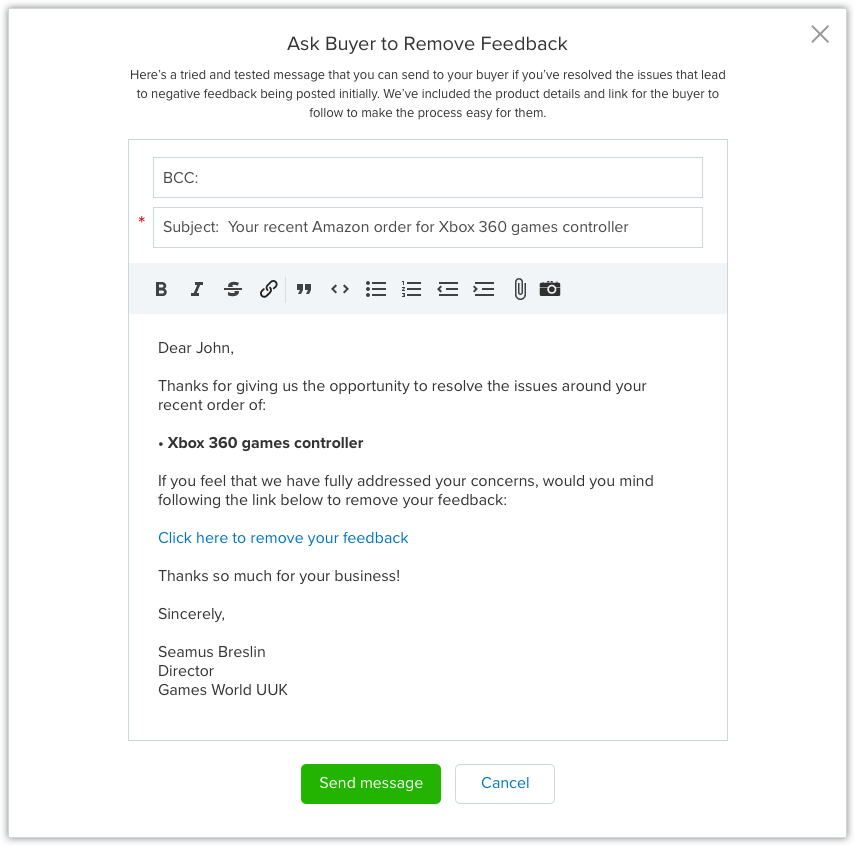Getting bad feedback can turn even the sunniest person into a grouch. It can feel like a personal slight, even if it isn’t. Luckily, it doesn’t have to be permanent and there are ways (plural!) of removing it. Read on to learn what FeedbackExpress has in store for you.
Approach it With the Right Mindset
Look, getting negative feedback sucks and there’s no other way to put it. But the way you approach and deal with it doesn’t have to be set in stone.
Amateur sellers look at it as the equivalent of a breakup, something devastating and a cause for mourning. But seasoned sellers see it a little differently.
They view negative feedback as just part of the job, and head it off before it ever develops into something more. These merchants take the necessary steps to minimise and remove it so they can keep their seller rating intact and high, retain their selling privileges, and move onto the next piece of business.
They don’t sweat every single unhappy word they come across because they know the threshold for negatives is 5% or less for their feedback rating, and they also know things like Order Defect Rate are only marked once (even if it’s comprised of more than one).
Learn the Best and Most Efficient Ways of Removing Negative Feedback
Your top goal should always be excellent customer service. If you approach selling with this mindset, it can help minimise upset buyers and negative reviews.
After that, your second goal should be maintaining an excellent seller rating, which helps tell prospective buyers that your number one goal is excellent customer service. The two go hand-in-hand, which is why removing bad reviews should be dealt with swiftly and properly.
We say swiftly, despite the fact that Amazon gives you a 60-day window for removing the feedback, because the sooner you can get it off, the less you risk buyers seeing it.
Plus, addressing it right away removes the chance of not being able to erasing it, which can no longer be done after the 60 days are up. S
o right off the bat, you need to put as much time on your side as possible. But what next?
How do you choose which approach to take in removing the negative feedback? Well, there are a couple of different ways, so let’s take a look.
Approach #1: Get Amazon to Do It
This is probably the easiest way of going about things, but perhaps also the most limiting.
To qualify, the feedback has to meet several criteria:
- It has to be written about a Fulfilled by Amazon (FBA) product.
- The feedback has to be only about the customer service you’ve provided, and/or the fulfilment process, and/or about the product. In the first two instances, Amazon will strike through the comment and put in their own note that says why the review doesn’t count.
- The buyer used one of George Carlin’s seven words you can’t say on TV (or the ones listed in Amazon’s guidelines) in their review, which is a big no-no.
- The person complains about pricing.
- They’ve included sensitive information, like email addresses, street addresses, phone numbers or other similar info.
Approach #2: Convince the Buyer to Remove It
If the feedback unfortunately doesn’t meet the above criteria, all is not yet lost!
You can still reach out to the buyer and talk with them, and see if you can’t both work out something mutually agreeable to have the feedback removed. Again, you’re restricted by the 60-day window, so act fast.
Your first step should be to send them a message.
Start off on a friendly note and introduce yourself, offer a genuine apology that has to do with why they’re upset, touch on their feedback by summarising it in one line, and ask them for more clarification about why they wrote what they did. End up your message by asking if you can do something to make it right, but it’s best to be specific.
Instead of saying just that, like ‘what can I do to improve things?’, give them a few options instead.
The most-used ones are to offer a refund or to tweak the order.
And above all, don’t forget to ask them to remove it!
Amazon allows you to contact the buyer more than once, but make sure not get all stalk-y about it.
The last thing you want is for them to contact Amazon and say they’ve been harassed by you or they feel you’re trying to manipulate them into removing the negative review.
Just remember to be polite and professional.
The Concrete Steps You Should Take
So we’ve covered the abstract approaches you can take in removing negative feedback, but how do you turn that into reality? Simple, there are only a few steps you have to take to get from Point A to happy times.
Step One: Log In

Whether you’re using FeedbackExpress or just your Amazon Seller Central account, you’ll want to log in to get at the good stuff. If you’re going the vanilla Amazon way, they have a bunch of pages that’ll help you, whether you want to refresh yourself on their guidelines, get rid of third-party feedback or use Feedback Manager.
In their FAQs, one thing Amazon recommends is to ‘learn from it and let it go’, but we feel that’s a way of stopping short. Always try and find a way to have the review removed and never be satisfied with just letting it hang around.
But really, there are simpler ways of going about it where you don’t have to stress yourself out as much or devote so much time to the process. Using a good Amazon feedback tool (-raises eyebrows- wonder who that could be? -whistles-) does it for you, and pro sellers use this method so they can pay attention to areas of their work that need an artistic touch.
So, instead of logging in to your Seller Central account, fire up FeedbackExpress instead.
Step Two: Really Pay Attention to the Words

It may be tempting to just shoot off a quick message to start the ball rolling, but that’s never a good idea.
First of all, you’re dealing with someone who was upset enough about the experience they’ve channelled it into words, and second of all, they’re going to feel even worse if they receive a generic message that doesn’t speak to them personally.
It’s like if you apply and interview for a job, and then get that bland email telling you that while you’re a great candidate, they’re just going to go with someone else at this time. It’s a horrible thing to receive, so never be the sender of such a missive and really read what the person is telling you.
Once you’ve read over it a couple times, step away from it for a full day. If you stare at it for too long, you’ll be applying your own lens to their words and you’ll lose the ability to really understand what they’re saying.
You’ve got 60 days, right, so take some time to read the review and think about how it applies to you as the seller.
What this tiny period of time also accomplishes is helping remove the emotion from the situation so you’re not all fired up when you do sit down to respond to them.
Think of a time when you were broken up with as a teen and how much that stung, and what running into them 20 years later would be like. There might still be emotion, sure, but the heat of the moment has long passed and you’re able to look at it with different eyes.
You can use this cooling off period to review other things like:
- Order date
- Feedback date
- Method of communication you’ll want to use
Step Three: Ask Them to Remove It

This part often gives sellers a case of the nerves, but it shouldn’t.
It’s business, and you’re doing what every other seller does. You’re not asking your mother to cook you something that doesn’t taste bad and burn-y, you’re just contacting the buyer about the next step in the shopping process.
You can choose from a bunch of different templates if you want, depending on how you’re going about this step and which feedback tool you’re using, but the part you should really be focusing on is the message body. Here is where you’ll want to use our advice from before and really customise it.
Remember:
- Introduce yourself.
- Offer a genuine apology, and not a Trumpian one (i.e. ‘I’m sorry if…’).
- Summarise their complaint and address it in your own words.
- Ask them if you missed anything, or if they could elaborate so that you can truly understand where they’re coming from.
- Offer one to three suggestions of things you can do to make it right, such as refunding the order, amending it or something else that appeals to them.
- Ask them to remove the feedback.
- Send the message.
As you get more and more advanced as a seller, you’ll realise that this part of operations really doesn’t have to be done by you. Unless you’re a part-time merchant or one who deals with a small inventory, there’s really no good reason for you to manually do this in your Seller Central account — and especially not when there’s a helper like FeedbackExpress to do it for you. Ooh, and want to know why else we rock and can take your headaches away? When you sign up now, you get the first 14 days free!



